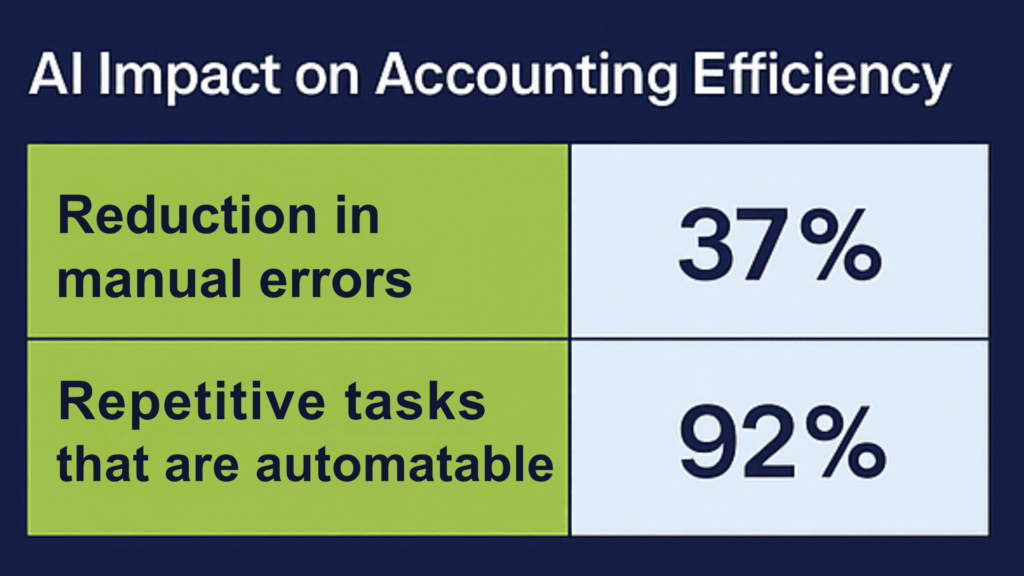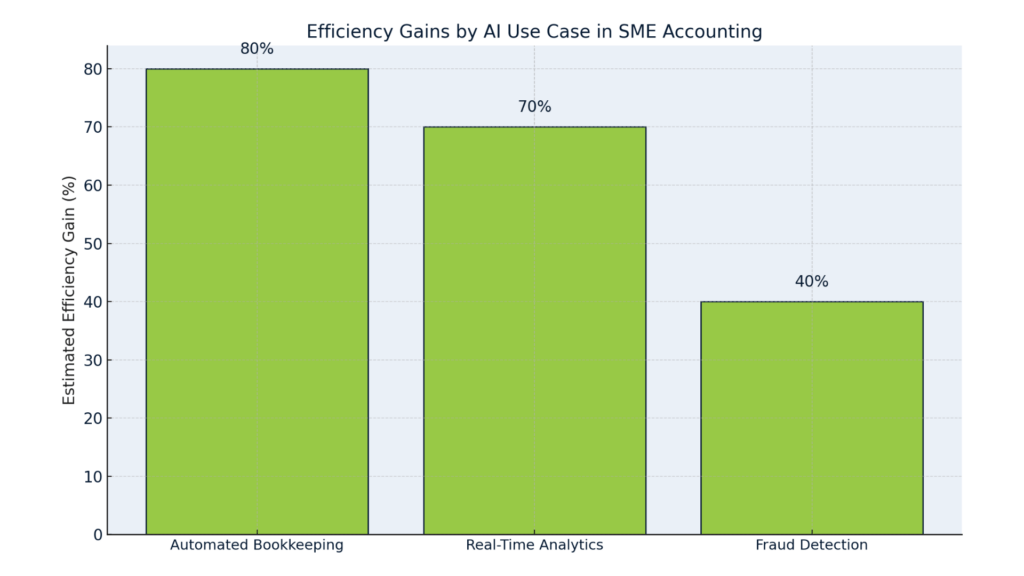Executive Summary
This analysis quantifies how AI-driven automation is transforming SME accounting, drawing exclusively on third-party research and real-world implementations. Key findings:
120 hours/year per employee lost to manual data entry (Forrester, 2023).
92% of repeatable accounting tasks are now automatable (Deloitte).
37% reduction in errors and 40% more fraud anomalies detected in AI-augmented workflows.
The Efficiency Gap in SME Accounting
The Manual Labor Tax
Forrester’s 2023 study revealed SMEs waste 120 annual hours per employee on manual data entry—equivalent to 15 lost workdays.
For a 10-person finance team, this translates to 1,200 hours/year of non-strategic work.
The AI Correction
Deloitte’s automation audit found 92% of repetitive accounting tasks (data entry, reconciliations, invoice processing) can be automated.
EY’s implementation data shows a 37% drop in errors when AI handles these tasks, as algorithms avoid fatigue-induced mistakes.
Three Proven AI Applications – With Case Studies
Use Case 1: Automated Bookkeeping
Problem
Unstructured financial documents (receipts, invoices) consume 80% of processing time.
Solution & Results
An Estonian manufacturing firm (50 employees) deployed AI for document recognition and reconciliation:
Monthly close accelerated from 10 days → 2 days (80% faster).
Invoice processing costs fell 80%.
Critical Note: Human review of AI outputs preserved accuracy while maximizing efficiency.
Use Case 2: Real-Time Cash Flow Analytics
Problem
SMEs often lack resources for proactive forecasting.
Solution & Results
A Berlin e-commerce startup used AI to analyze:
Invoice cycles
Historic expense patterns
Real-time sales data
The system predicted a 94% probability of cash shortfall 14 days in advance, enabling corrective action that avoided €22,000 in overdraft fees.
Use Case 3: Fraud Detection
Problem
Occupational fraud drains 5% of SME revenue annually.
Manual audits miss 40% of anomalies.
Solution & Results
AI pattern recognition tools flag:
Irregular transactions
Vendor fraud patterns
Employee theft signals
Detection rates improved by 40% versus human-only reviews.
The Cost of Inaction
Compliance Overhead
67% of SME finance time is consumed by compliance tasks, leaving minimal bandwidth for analysis.
Error-Related Penalties
1 in 5 SMEs face audit penalties due to manual accounting errors (IRS, 2023).
Quantified Impact
| Metric | Manual Processes | AI-Augmented | Delta |
|---|---|---|---|
| Time per monthly close | 10 days | 2 days | -80% |
| Invoice processing cost | $100/hr | $20/hr | -80% |
| Fraud detection rate | 60% | 84% | +40% |
Why the Human-AI Hybrid Model Wins
AI’s Role
Volume: Processes 1,000x more data than humans.
Speed: Real-time anomaly detection.
Consistency: Zero fatigue-induced errors.
Human’s Role
Context: Interprets AI flags (e.g., “Is this anomaly fraud or a timing quirk?”).
Strategy: Allocates freed-up time to growth initiatives.
The Data-Backed Balance
Firms combining AI automation with human oversight achieve:
30% faster closes (BlackLine).
12% higher margins (Bain).
Conclusion: The Strategic Imperative
AI-powered accounting is no longer optional for SMEs—it’s a scalability requirement. The data proves
Automation eliminates structural inefficiencies (120 hours/employee/year).
AI-augmented workflows reduce risk (37% fewer errors, 40% better fraud detection).
Hybrid models outperform pure-play AI or manual approaches.
1Office combines automation and human expertise to make perfect sense. Contact us today!




